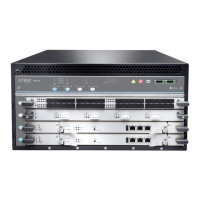g006040
USB
port
Reset
button
Extractor
clip
Extractor
clip
Console
port
Auxiliary
port
Ethernet
port
SSD
slot 2
SSD
slot 1
Each Routing Engine consists of the following components:
•
CPU—Runs Junos OS to maintain the router's routing tables and routing protocols..
•
DRAM—Provides storage for the routing and forwarding tables and for other Routing
Engine processes.
•
USB port—Provides a removable media interface through which you can install Junos
OS manually. Junos OS supports USB version 1.0.
•
CompactFlash card—Provides primary storage for software images, configuration files,
and microcode. The CompactFlash card is fixed and is inaccessible from outside the
router.
•
Solid-state Drive (SSD)—Provides secondary storage for log files, memory dumps,
and rebooting the system if the CompactFlash card fails.
•
Interface ports—The AUX, CONSOLE, and ETHERNET provide access to management
devices. Each Routing Engine has one 10/100/1000-Mbps Ethernetport for connecting
to a management network, and two asynchronous serial ports—one for connecting to
a console and one for connecting to a modem or other auxiliary device.
•
EEPROM—Stores the serial number of the Routing Engine.
•
RESET button—Reboots the Routing Engine when pressed.
•
ONLINE/OFFLINE button—Takes the Routing Engine online or offline when pressed.
•
Extractor clips—Used for inserting and extracting the Routing Engine.
•
Captive screws—Secure the Routing Engine in place.
NOTE: For specific information about Routing Engine components (for
example, the amount of DRAM), issue the show chassis routing-engine
command.
RE-S-1800 Routing Engine Boot Sequence
The router is shipped with Junos OS preinstalled on the Routing Engine. There are three
copies of software:
•
One copy on the CompactFlash card in the Routing Engine.
Copyright © 2017, Juniper Networks, Inc.28
MX240 3D Universal Edge Router Hardware Guide

